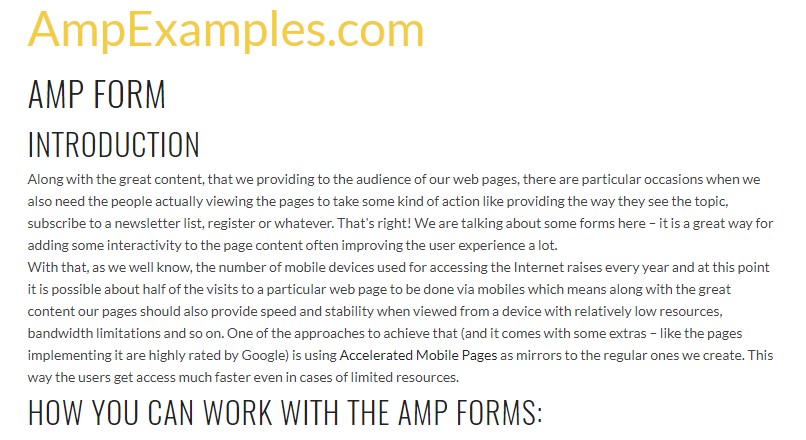Bootstrap Form Input
Intro
Bootstrap grants several form manage designs, layout opportunities, and also custom elements for producing a wide variety of Bootstrap Form Button.
Forms supply the excellent solution for having several comments directly from the visitors of our pages. In the event that it is actually a plain connection or else registration form having simply just a handful of areas as well as a highly developed and very well thought query the Bootstrap 4 system got all the things that is certainly needed to accomplish the job and obtain outstanding responsive appeal.
By default inside the Bootstrap framework the form elements are styled to span all width of its parent element-- this stuff gets accomplished by selecting the .form-control class. The controls and lebels ought to be wrapped in a parent element using the .form-group class for ideal spacing.
Bootstrap Form Field commands
Bootstrap's form controls expand regarding our Rebooted form looks with classes.
Employ these classes to opt right into their modified display screens for a more consistent rendering around internet browsers and gadgets . The representation form listed here shows usual HTML form components that acquire updated looks coming from Bootstrap along with extra classes.
Take note, due to the fact that Bootstrap makes use of the HTML5 doctype, all of inputs must feature a type attribute.
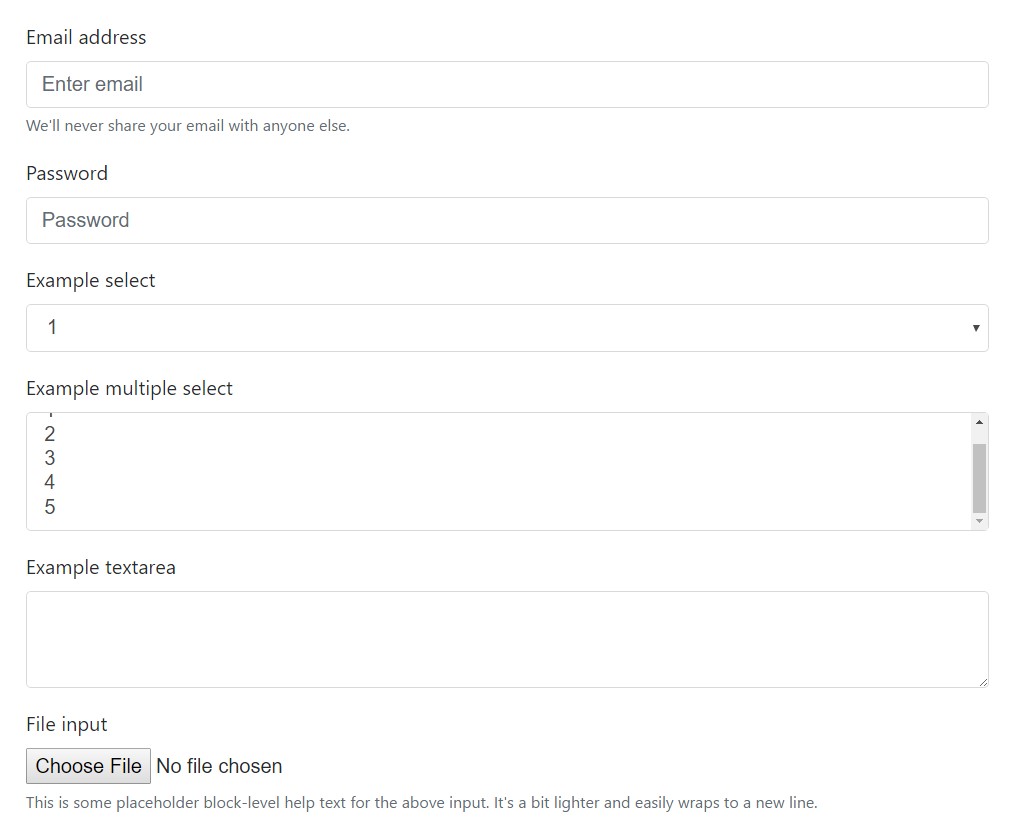

<form>
<div class="form-group">
<label for="exampleInputEmail1">Email address</label>
<input type="email" class="form-control" id="exampleInputEmail1" aria-describedby="emailHelp" placeholder="Enter email">
<small id="emailHelp" class="form-text text-muted">We'll never share your email with anyone else.</small>
</div>
<div class="form-group">
<label for="exampleInputPassword1">Password</label>
<input type="password" class="form-control" id="exampleInputPassword1" placeholder="Password">
</div>
<div class="form-group">
<label for="exampleSelect1">Example select</label>
<select class="form-control" id="exampleSelect1">
<option>1</option>
<option>2</option>
<option>3</option>
<option>4</option>
<option>5</option>
</select>
</div>
<div class="form-group">
<label for="exampleSelect2">Example multiple select</label>
<select multiple class="form-control" id="exampleSelect2">
<option>1</option>
<option>2</option>
<option>3</option>
<option>4</option>
<option>5</option>
</select>
</div>
<div class="form-group">
<label for="exampleTextarea">Example textarea</label>
<textarea class="form-control" id="exampleTextarea" rows="3"></textarea>
</div>
<div class="form-group">
<label for="exampleInputFile">File input</label>
<input type="file" class="form-control-file" id="exampleInputFile" aria-describedby="fileHelp">
<small id="fileHelp" class="form-text text-muted">This is some placeholder block-level help text for the above input. It's a bit lighter and easily wraps to a new line.</small>
</div>
<fieldset class="form-group">
<legend>Radio buttons</legend>
<div class="form-check">
<label class="form-check-label">
<input type="radio" class="form-check-input" name="optionsRadios" id="optionsRadios1" value="option1" checked>
Option one is this and that—be sure to include why it's great
</label>
</div>
<div class="form-check">
<label class="form-check-label">
<input type="radio" class="form-check-input" name="optionsRadios" id="optionsRadios2" value="option2">
Option two can be something else and selecting it will deselect option one
</label>
</div>
<div class="form-check disabled">
<label class="form-check-label">
<input type="radio" class="form-check-input" name="optionsRadios" id="optionsRadios3" value="option3" disabled>
Option three is disabled
</label>
</div>
</fieldset>
<div class="form-check">
<label class="form-check-label">
<input type="checkbox" class="form-check-input">
Check me out
</label>
</div>
<button type="submit" class="btn btn-primary">Submit</button>
</form>Shown below is a full listing of the unique Bootstrap Form Button commands sustained by Bootstrap as well as the classes which individualize them. Added documents is available for each and every group.
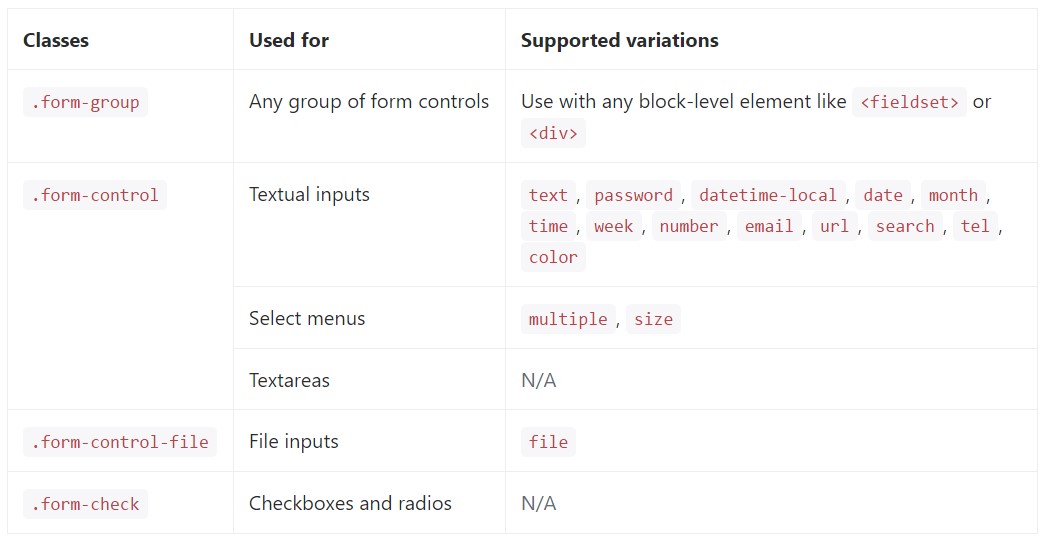
Textual inputs
Listed here are the some examples of .form-control applied to each textual HTML5 <input> type.
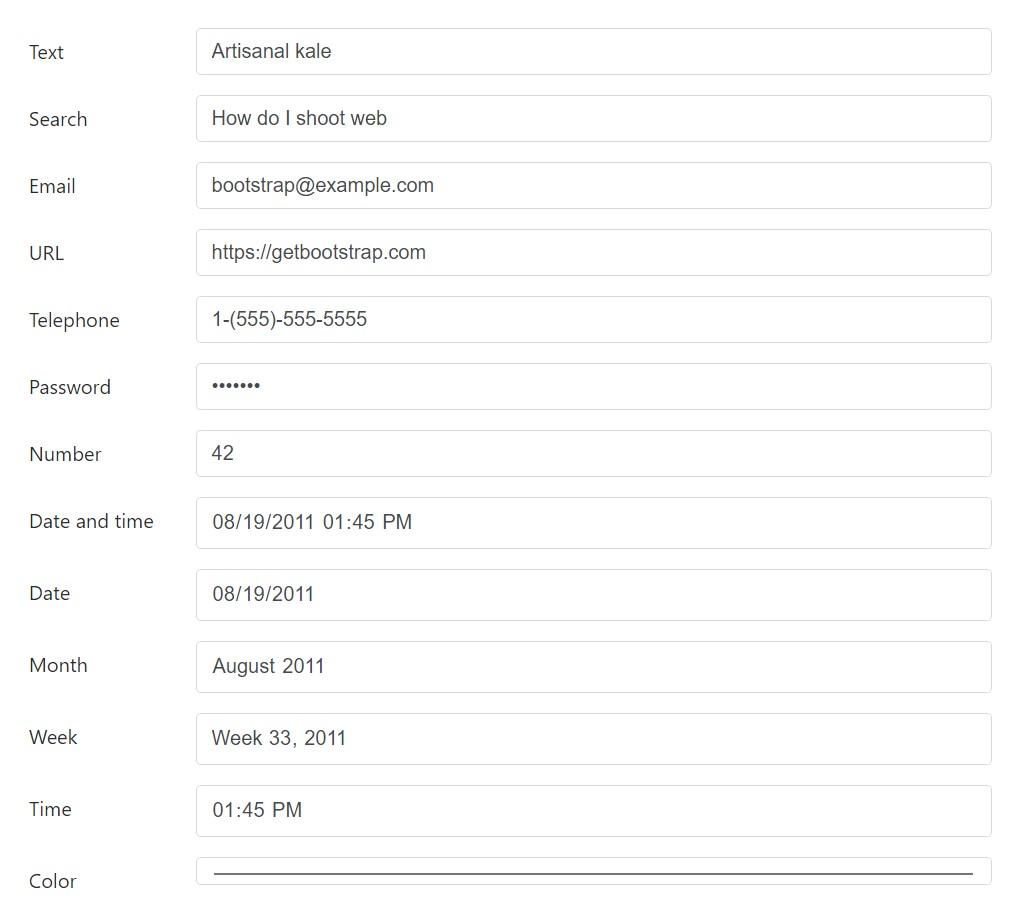
<div class="form-group row">
<label for="example-text-input" class="col-2 col-form-label">Text</label>
<div class="col-10">
<input class="form-control" type="text" value="Artisanal kale" id="example-text-input">
</div>
</div>
<div class="form-group row">
<label for="example-search-input" class="col-2 col-form-label">Search</label>
<div class="col-10">
<input class="form-control" type="search" value="How do I shoot web" id="example-search-input">
</div>
</div>
<div class="form-group row">
<label for="example-email-input" class="col-2 col-form-label">Email</label>
<div class="col-10">
<input class="form-control" type="email" value="[email protected]" id="example-email-input">
</div>
</div>
<div class="form-group row">
<label for="example-url-input" class="col-2 col-form-label">URL</label>
<div class="col-10">
<input class="form-control" type="url" value="https://getbootstrap.com" id="example-url-input">
</div>
</div>
<div class="form-group row">
<label for="example-tel-input" class="col-2 col-form-label">Telephone</label>
<div class="col-10">
<input class="form-control" type="tel" value="1-(555)-555-5555" id="example-tel-input">
</div>
</div>
<div class="form-group row">
<label for="example-password-input" class="col-2 col-form-label">Password</label>
<div class="col-10">
<input class="form-control" type="password" value="hunter2" id="example-password-input">
</div>
</div>
<div class="form-group row">
<label for="example-number-input" class="col-2 col-form-label">Number</label>
<div class="col-10">
<input class="form-control" type="number" value="42" id="example-number-input">
</div>
</div>
<div class="form-group row">
<label for="example-datetime-local-input" class="col-2 col-form-label">Date and time</label>
<div class="col-10">
<input class="form-control" type="datetime-local" value="2011-08-19T13:45:00" id="example-datetime-local-input">
</div>
</div>
<div class="form-group row">
<label for="example-date-input" class="col-2 col-form-label">Date</label>
<div class="col-10">
<input class="form-control" type="date" value="2011-08-19" id="example-date-input">
</div>
</div>
<div class="form-group row">
<label for="example-month-input" class="col-2 col-form-label">Month</label>
<div class="col-10">
<input class="form-control" type="month" value="2011-08" id="example-month-input">
</div>
</div>
<div class="form-group row">
<label for="example-week-input" class="col-2 col-form-label">Week</label>
<div class="col-10">
<input class="form-control" type="week" value="2011-W33" id="example-week-input">
</div>
</div>
<div class="form-group row">
<label for="example-time-input" class="col-2 col-form-label">Time</label>
<div class="col-10">
<input class="form-control" type="time" value="13:45:00" id="example-time-input">
</div>
</div>
<div class="form-group row">
<label for="example-color-input" class="col-2 col-form-label">Color</label>
<div class="col-10">
<input class="form-control" type="color" value="#563d7c" id="example-color-input">
</div>
</div>Form layouts
Since Bootstrap employs display: block and width :100% to mostly all our form controls, forms will definitely by default stack vertically. Alternative classes may possibly be utilized to vary this specific layout on a per-form basis.
Form sets
The .form-group class is the most convenient procedure to provide remarkable building to forms. Its primary function is to supply margin-bottom about a label and deal with pairing. As a bonus, given that it's a class you can easily utilize it utilizing <fieldset>-s, <div>-s, or almost any other element.

<form>
<div class="form-group">
<label for="formGroupExampleInput">Example label</label>
<input type="text" class="form-control" id="formGroupExampleInput" placeholder="Example input">
</div>
<div class="form-group">
<label for="formGroupExampleInput2">Another label</label>
<input type="text" class="form-control" id="formGroupExampleInput2" placeholder="Another input">
</div>
</form>Inline forms
Operate the .form-inline class to feature a number of labels, form regulations , and also tabs on a singular horizontal row. Form controls inside inline forms can vary slightly from their default states.
- Controls are display: flex, collapsing any sort of HTML white colored area and permitting you to provide alignment regulation including spacing and flexbox utilities.
- Controls and input groups receive width: auto to override the Bootstrap default width: 100%.
- Controls only appear inline in viewports that are at very least 576px wide to consider small viewports on mobile devices.
You may perhaps have to by hand fix the size and arrangement of individual form controls with spacing utilities (as demonstrated below) Lastly, don't forget to regularly incorporate a <label> with each form control, even though you need to conceal it directly from non-screenreader visitors with a code.

<form class="form-inline">
<label class="sr-only" for="inlineFormInput">Name</label>
<input type="text" class="form-control mb-2 mr-sm-2 mb-sm-0" id="inlineFormInput" placeholder="Jane Doe">
<label class="sr-only" for="inlineFormInputGroup">Username</label>
<div class="input-group mb-2 mr-sm-2 mb-sm-0">
<div class="input-group-addon">@</div>
<input type="text" class="form-control" id="inlineFormInputGroup" placeholder="Username">
</div>
<div class="form-check mb-2 mr-sm-2 mb-sm-0">
<label class="form-check-label">
<input class="form-check-input" type="checkbox"> Remember me
</label>
</div>
<button type="submit" class="btn btn-primary">Submit</button>
</form>Customized form controls also picks are additionally supported.

<form class="form-inline">
<label class="mr-sm-2" for="inlineFormCustomSelect">Preference</label>
<select class="custom-select mb-2 mr-sm-2 mb-sm-0" id="inlineFormCustomSelect">
<option selected>Choose...</option>
<option value="1">One</option>
<option value="2">Two</option>
<option value="3">Three</option>
</select>
<label class="custom-control custom-checkbox mb-2 mr-sm-2 mb-sm-0">
<input type="checkbox" class="custom-control-input">
<span class="custom-control-indicator"></span>
<span class="custom-control-description">Remember my preference</span>
</label>
<button type="submit" class="btn btn-primary">Submit</button>
</form>Alternatives to covered labels
Assistive systems such as screen readers will definitely have difficulty using your forms in case you don't feature a label for every single input. For these types of inline forms, you can certainly conceal the labels applying the .sr-only class. There are actually additional other approaches of presenting a label for assistive technological innovations, like the aria-label, aria-labelledby or title attribute. If not any of these are present, assistive technologies may perhaps resort to applying the placeholder attribute, in the case that available, but note that utilization of placeholder as a replacement for other labelling approaches is not really recommended.
Working with the Grid
For additionally organized form layouts that are in addition responsive, you have the ability to implement Bootstrap's predefined grid classes as well as mixins to develop horizontal forms. Add in the .row class to form groups and make use of the .col-*-* classes in order to define the width of your labels and controls.
Be sure to add .col-form-label to your <label>-s as well so they’re vertically centered with their associated form controls. For <legend> elements, you can use .col-form-legend to make them appear similar to regular <label> elements.
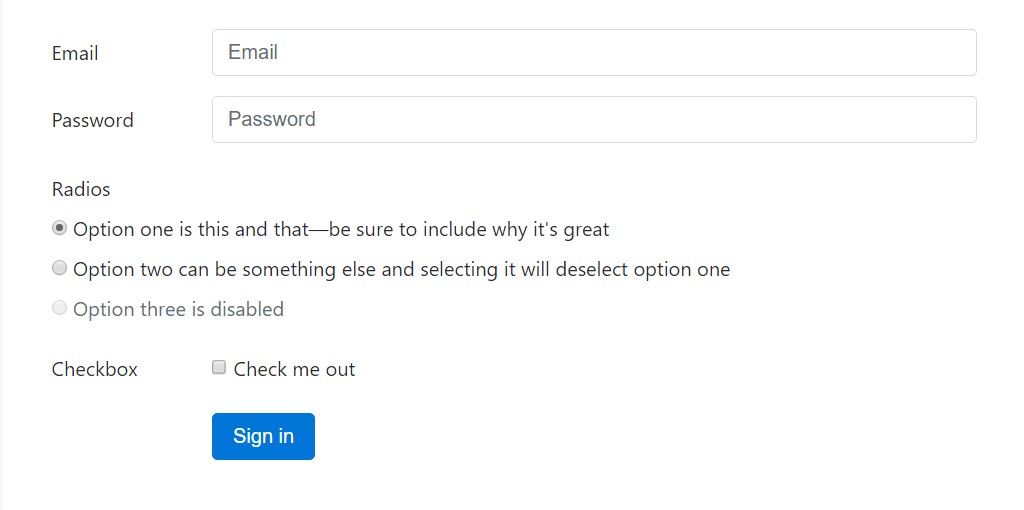
<div class="container">
<form>
<div class="form-group row">
<label for="inputEmail3" class="col-sm-2 col-form-label">Email</label>
<div class="col-sm-10">
<input type="email" class="form-control" id="inputEmail3" placeholder="Email">
</div>
</div>
<div class="form-group row">
<label for="inputPassword3" class="col-sm-2 col-form-label">Password</label>
<div class="col-sm-10">
<input type="password" class="form-control" id="inputPassword3" placeholder="Password">
</div>
</div>
<fieldset class="form-group row">
<legend class="col-form-legend col-sm-2">Radios</legend>
<div class="col-sm-10">
<div class="form-check">
<label class="form-check-label">
<input class="form-check-input" type="radio" name="gridRadios" id="gridRadios1" value="option1" checked>
Option one is this and that—be sure to include why it's great
</label>
</div>
<div class="form-check">
<label class="form-check-label">
<input class="form-check-input" type="radio" name="gridRadios" id="gridRadios2" value="option2">
Option two can be something else and selecting it will deselect option one
</label>
</div>
<div class="form-check disabled">
<label class="form-check-label">
<input class="form-check-input" type="radio" name="gridRadios" id="gridRadios3" value="option3" disabled>
Option three is disabled
</label>
</div>
</div>
</fieldset>
<div class="form-group row">
<label class="col-sm-2">Checkbox</label>
<div class="col-sm-10">
<div class="form-check">
<label class="form-check-label">
<input class="form-check-input" type="checkbox"> Check me out
</label>
</div>
</div>
</div>
<div class="form-group row">
<div class="offset-sm-2 col-sm-10">
<button type="submit" class="btn btn-primary">Sign in</button>
</div>
</div>
</form>
</div>Grid-based form configurations additionally sustain small-sized and large size inputs.

<div class="container">
<form>
<div class="form-group row">
<label for="lgFormGroupInput" class="col-sm-2 col-form-label col-form-label-lg">Email</label>
<div class="col-sm-10">
<input type="email" class="form-control form-control-lg" id="lgFormGroupInput" placeholder="[email protected]">
</div>
</div>
<div class="form-group row">
<label for="smFormGroupInput" class="col-sm-2 col-form-label col-form-label-sm">Email</label>
<div class="col-sm-10">
<input type="email" class="form-control form-control-sm" id="smFormGroupInput" placeholder="[email protected]">
</div>
</div>
</form>
</div>Checkboxes and radios
Default checkboxes and radios are raised upon with the assistance of .form-check, a singular class for both input types that develops the layout and behaviour of their HTML components. Checkboxes are for selecting one as well as a number of choices inside a selection, as long as radios are for picking one capability from numerous.
The disabled class will at the same time make lighter the message color tone to help reveal the input's state.
Each and every checkbox and radio is wrapped inside a <label> because of three good reasons:
- It delivers a bigger hit areas for checking the control.
- It grants a semantic and practical wrapper to help us substitute the default <input>-s.
- It triggers the state of the <input> automatically, indicating no JavaScript is demanded.
We cover up the default <input> together with opacity and employ the .custom-control-indicator to develop a new custom form indicator in its place. Unfortunately we aren't able to create a custom-made one from just the <input> due to the fact that CSS's content doesn't function on that element..
We employ the sibling selector (~) for every our <input> states-- such as : checked-- to appropriately style our custom made form indication . While combined along with the .custom-control-description class, we have the ability to also style the content for each and every item formed on the <input>-s state.
In the checked states, we use base64 embedded SVG icons from Open Iconic. This provides us the best control for styling and positioning across browsers and devices.
Checkboxes

<label class="custom-control custom-checkbox">
<input type="checkbox" class="custom-control-input">
<span class="custom-control-indicator"></span>
<span class="custom-control-description">Check this custom checkbox</span>
</label>Custom checkboxes can in addition use the : indeterminate pseudo class if manually fixed with JavaScript (there is no attainable HTML attribute for identifying it).

In case you're using jQuery, something such as this should be good enough:
$('.your-checkbox').prop('indeterminate', true)Radios

<label class="custom-control custom-radio">
<input id="radio1" name="radio" type="radio" class="custom-control-input">
<span class="custom-control-indicator"></span>
<span class="custom-control-description">Toggle this custom radio</span>
</label>
<label class="custom-control custom-radio">
<input id="radio2" name="radio" type="radio" class="custom-control-input">
<span class="custom-control-indicator"></span>
<span class="custom-control-description">Or toggle this other custom radio</span>
</label>Default (stacked)
By default, any variety of checkboxes and radios that are actually close sibling will be vertically stacked as well as appropriately spaced by using .form-check.

<div class="form-check">
<label class="form-check-label">
<input class="form-check-input" type="checkbox" value="">
Option one is this and that—be sure to include why it's great
</label>
</div>
<div class="form-check disabled">
<label class="form-check-label">
<input class="form-check-input" type="checkbox" value="" disabled>
Option two is disabled
</label>
</div>
<div class="form-check">
<label class="form-check-label">
<input class="form-check-input" type="radio" name="exampleRadios" id="exampleRadios1" value="option1" checked>
Option one is this and that—be sure to include why it's great
</label>
</div>
<div class="form-check">
<label class="form-check-label">
<input class="form-check-input" type="radio" name="exampleRadios" id="exampleRadios2" value="option2">
Option two can be something else and selecting it will deselect option one
</label>
</div>
<div class="form-check disabled">
<label class="form-check-label">
<input class="form-check-input" type="radio" name="exampleRadios" id="exampleRadios3" value="option3" disabled>
Option three is disabled
</label>
</div>Inline
Group checkboxes as well as radios on the exact same horizontal row with adding .form-check-inline to any .form-check.

<div class="form-check form-check-inline">
<label class="form-check-label">
<input class="form-check-input" type="checkbox" id="inlineCheckbox1" value="option1"> 1
</label>
</div>
<div class="form-check form-check-inline">
<label class="form-check-label">
<input class="form-check-input" type="checkbox" id="inlineCheckbox2" value="option2"> 2
</label>
</div>
<div class="form-check form-check-inline disabled">
<label class="form-check-label">
<input class="form-check-input" type="checkbox" id="inlineCheckbox3" value="option3" disabled> 3
</label>
</div>
<div class="form-check form-check-inline">
<label class="form-check-label">
<input class="form-check-input" type="radio" name="inlineRadioOptions" id="inlineRadio1" value="option1"> 1
</label>
</div>
<div class="form-check form-check-inline">
<label class="form-check-label">
<input class="form-check-input" type="radio" name="inlineRadioOptions" id="inlineRadio2" value="option2"> 2
</label>
</div>
<div class="form-check form-check-inline disabled">
<label class="form-check-label">
<input class="form-check-input" type="radio" name="inlineRadioOptions" id="inlineRadio3" value="option3" disabled> 3
</label>
</div>Without any labels
You should not provide a text message within the <label>, the input is positioned as you would undoubtedly demand. Currently exclusively works with non-inline checkboxes and radios. Bear in mind to also produce some type of label for assistive systems ( as an example, applying aria-label).

<div class="form-check">
<label class="form-check-label">
<input class="form-check-input" type="checkbox" id="blankCheckbox" value="option1" aria-label="...">
</label>
</div>
<div class="form-check">
<label class="form-check-label">
<input class="form-check-input" type="radio" name="blankRadio" id="blankRadio1" value="option1" aria-label="...">
</label>
</div>Static regulations
In case you have to place plain message next to a form label inside a form, apply the .form-control-static class on an element of your decision.

<form>
<div class="form-group row">
<label class="col-sm-2 col-form-label">Email</label>
<div class="col-sm-10">
<p class="form-control-static">[email protected]</p>
</div>
</div>
<div class="form-group row">
<label for="inputPassword" class="col-sm-2 col-form-label">Password</label>
<div class="col-sm-10">
<input type="password" class="form-control" id="inputPassword" placeholder="Password">
</div>
</div>
</form>
<form class="form-inline">
<div class="form-group">
<label class="sr-only">Email</label>
<p class="form-control-static">[email protected]</p>
</div>
<div class="form-group mx-sm-3">
<label for="inputPassword2" class="sr-only">Password</label>
<input type="password" class="form-control" id="inputPassword2" placeholder="Password">
</div>
<button type="submit" class="btn btn-primary">Confirm identity</button>
</form>Disabled forms
Provide the disabled boolean attribute for an input to keep user interactions. Disabled inputs appear lighter and put in a not-allowed cursor.
<input class="form-control" id="disabledInput" type="text" placeholder="Disabled input here..." disabled>Provide the disabled attribute to a <fieldset> in order to turn off all of the regulations within.
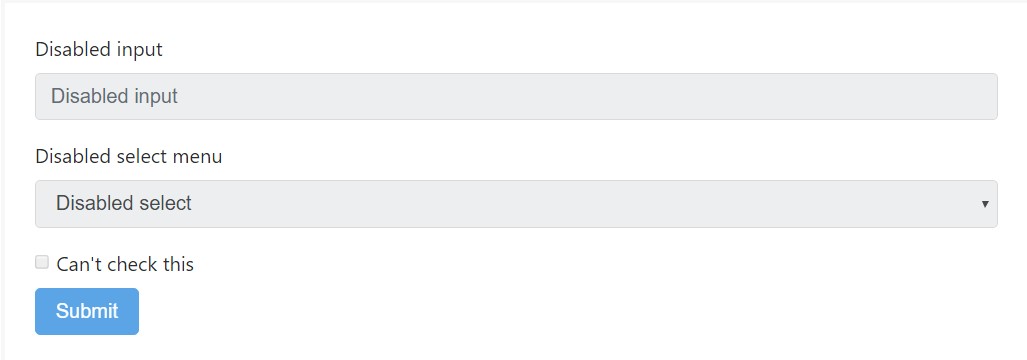
<form>
<fieldset disabled>
<div class="form-group">
<label for="disabledTextInput">Disabled input</label>
<input type="text" id="disabledTextInput" class="form-control" placeholder="Disabled input">
</div>
<div class="form-group">
<label for="disabledSelect">Disabled select menu</label>
<select id="disabledSelect" class="form-control">
<option>Disabled select</option>
</select>
</div>
<div class="checkbox">
<label>
<input type="checkbox"> Can't check this
</label>
</div>
<button type="submit" class="btn btn-primary">Submit</button>
</fieldset>
</form>Caveat concerning link capabilities of <a>
By default, web browsers will definitely handle all of the essential form controls (<input>, <select> and <button> features) inside a <fieldset disabled> as disabled, evading both the key board plus computer mouse interactions on all of them. However, in case your form as well incorporates <a ... class="btn btn-*"> features, these are going to just be delivered a look of pointer-events: none. As mentioned inside the section in relation to disabled state for buttons (and esspecially in the sub-section for anchor aspects ), this particular CSS feature is not yet standardized and isn't entirely maintained in Opera 18 and below, or else in Internet Explorer 11, and will not keep computer keyboard users from being able to direct or activate such web links. And so to remain safe, use custom-made JavaScript to turn off this kind of links.
Cross-browser unity
Even though Bootstrap is going to utilize these styles in all browsers, Internet Explorer 11 and below don't completely support the disabled attribute on a <fieldset>.Use custom JavaScript to turn off the fieldset in these kinds of internet browsers.
Readonly inputs
Include the readonly boolean attribute on an input to avoid modification of the input's value. Read-only inputs show up lighter ( the same as disabled inputs), but hold the regular pointer.

<input class="form-control" type="text" placeholder="Readonly input here…" readonly>Command proportions
Specify heights applying classes like .form-control-lg, and also set on widths applying grid column classes just like .col-lg-*.

<input class="form-control form-control-lg" type="text" placeholder=".form-control-lg">
<input class="form-control" type="text" placeholder="Default input">
<input class="form-control form-control-sm" type="text" placeholder=".form-control-sm">
<select class="form-control form-control-lg">
<option>Large select</option>
</select>
<select class="form-control">
<option>Default select</option>
</select>
<select class="form-control form-control-sm">
<option>Small select</option>
</select>Column sizing
Wrap inputs in a grid columns, as well as any custom made parent feature, in order to simply enforce the desired widths.

<div class="row">
<div class="col-2">
<input type="text" class="form-control" placeholder=".col-2">
</div>
<div class="col-3">
<input type="text" class="form-control" placeholder=".col-3">
</div>
<div class="col-4">
<input type="text" class="form-control" placeholder=".col-4">
</div>
</div>Help content
The .help-block class is given up in the brand new version. If you need to set special more content to assist your site visitors to better get around - employ the .form-text class instead. Bootstrap 4 possesses special built within validation styles for the form controls being utilized . Within this version the .has-feedback class has been lost-- it's no longer needed to have along with the introduction of the .form-control-danger, .form-control-warning and .form-control-success classes bring in a small info icon directly in the input fields.
Associating support text message along with form controls
Guide message ought to be explicitly related to the form control it really connects to employing the aria-describedby attribute. This will definitely make sure that the assistive technologies-- for instance, screen readers-- will reveal this guide message if the user focuses or gets in the control.
Block level
Block assistance content-- for below inputs or for extended words of the guidance text message-- can possibly be simply achieved by using .form-text. This specific class provides display: block plus adds some top margin for convenient spacing from the inputs mentioned above.

<label for="inputPassword5">Password</label>
<input type="password" id="inputPassword5" class="form-control" aria-describedby="passwordHelpBlock">
<p id="passwordHelpBlock" class="form-text text-muted">
Your password must be 8-20 characters long, contain letters and numbers, and must not contain spaces, special characters, or emoji.
</p>Inline
Inline text message have the ability to work with any type of usual inline HTML element (be it a , <span>, or another thing).

<form class="form-inline">
<div class="form-group">
<label for="inputPassword4">Password</label>
<input type="password" id="inputPassword4" class="form-control mx-sm-3" aria-describedby="passwordHelpInline">
<small id="passwordHelpInline" class="text-muted">
Must be 8-20 characters long.
</small>
</div>
</form>Validation
Bootstrap provides validation designs for success, danger, and warning states on a large number of form controls.
Efficient ways to apply
Here's a rundown of ways in which they function:
- To apply, add in .has-warning, .has-danger, or .has-success to the parent feature. Any sort of .col-form-label, .form-control, as well as customized form component will acquire the validation styles.
- Contextual validation content, in addition to your typical form field support words, may be included with the operation of .form-control-feedback. This particular content will adapt to the parent .has-* class. By default it simply features a bit of margin for spacing and also a transformed color for each state.
- Validation icons are url()-s designed via Sass variables that are applied to background-image declarations for each and every state.
- You can employ your unique base64 PNGs or even SVGs with updating the Sass variables as well as recompiling.
- Icons have the ability to additionally be disabled absolutely via setting up the variables to none or commenting out the source Sass.
Defining forms
Usually stating, you'll want to work with a specific state for particular styles of feedback:
- Danger is great for when there's a blocking or else needed field. A user must write in this field correctly to submit the form.
- Warning performs successfully for input values which are in development, like password strength, or soft validation just before a user attempts to submit a form.
- And lastly, success is suitable for circumstances when you have per-field validation throughout a form and also need to motivate a user throughout the remaining fields.
Case studies
Here are some good examples of the previously mentioned classes at work. First off is your regular left-aligned fields with labels, guide message, and validation message.
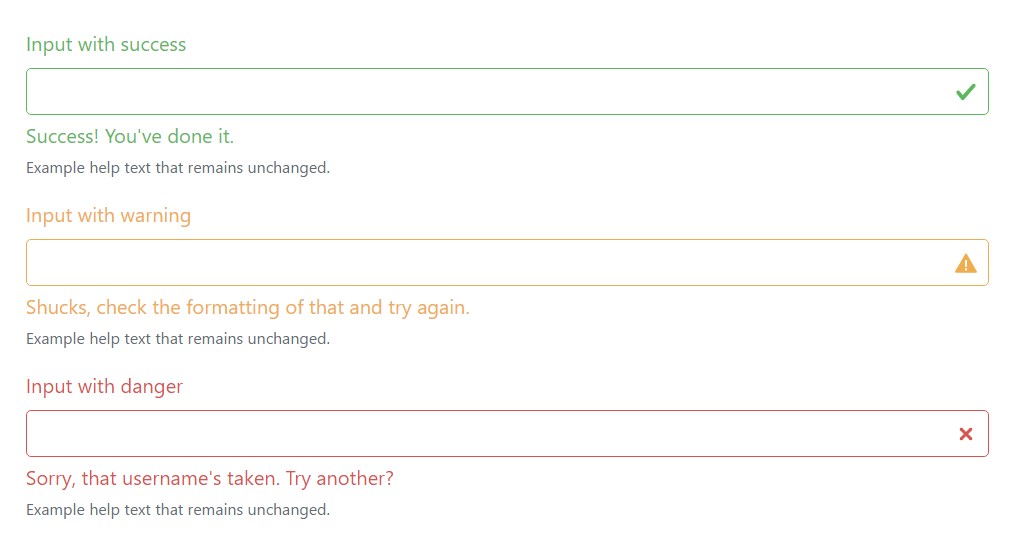
<div class="form-group has-success">
<label class="form-control-label" for="inputSuccess1">Input with success</label>
<input type="text" class="form-control form-control-success" id="inputSuccess1">
<div class="form-control-feedback">Success! You've done it.</div>
<small class="form-text text-muted">Example help text that remains unchanged.</small>
</div>
<div class="form-group has-warning">
<label class="form-control-label" for="inputWarning1">Input with warning</label>
<input type="text" class="form-control form-control-warning" id="inputWarning1">
<div class="form-control-feedback">Shucks, check the formatting of that and try again.</div>
<small class="form-text text-muted">Example help text that remains unchanged.</small>
</div>
<div class="form-group has-danger">
<label class="form-control-label" for="inputDanger1">Input with danger</label>
<input type="text" class="form-control form-control-danger" id="inputDanger1">
<div class="form-control-feedback">Sorry, that username's taken. Try another?</div>
<small class="form-text text-muted">Example help text that remains unchanged.</small>
</div>All those same states have the ability to in addition be employed together with horizontal forms.
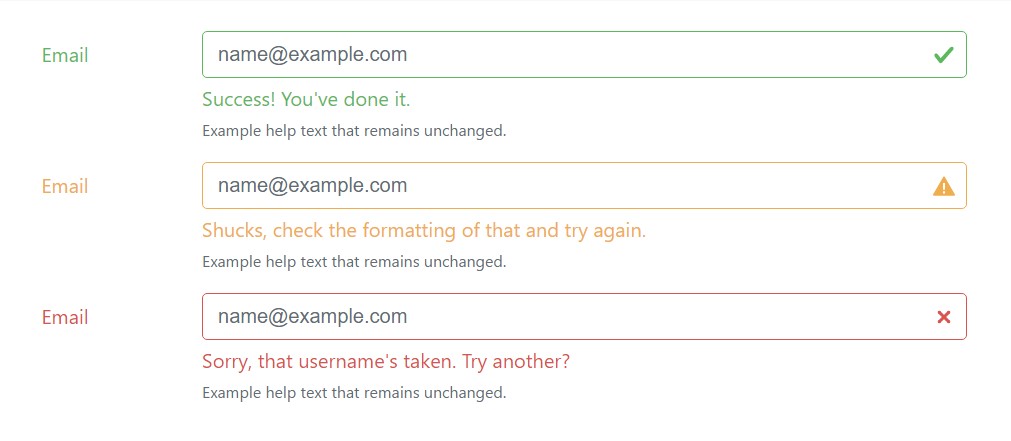
<div class="container">
<form>
<div class="form-group row has-success">
<label for="inputHorizontalSuccess" class="col-sm-2 col-form-label">Email</label>
<div class="col-sm-10">
<input type="email" class="form-control form-control-success" id="inputHorizontalSuccess" placeholder="[email protected]">
<div class="form-control-feedback">Success! You've done it.</div>
<small class="form-text text-muted">Example help text that remains unchanged.</small>
</div>
</div>
<div class="form-group row has-warning">
<label for="inputHorizontalWarning" class="col-sm-2 col-form-label">Email</label>
<div class="col-sm-10">
<input type="email" class="form-control form-control-warning" id="inputHorizontalWarning" placeholder="[email protected]">
<div class="form-control-feedback">Shucks, check the formatting of that and try again.</div>
<small class="form-text text-muted">Example help text that remains unchanged.</small>
</div>
</div>
<div class="form-group row has-danger">
<label for="inputHorizontalDnger" class="col-sm-2 col-form-label">Email</label>
<div class="col-sm-10">
<input type="email" class="form-control form-control-danger" id="inputHorizontalDnger" placeholder="[email protected]">
<div class="form-control-feedback">Sorry, that username's taken. Try another?</div>
<small class="form-text text-muted">Example help text that remains unchanged.</small>
</div>
</div>
</form>
</div>Radios and checkboxes happen to be also maintained.

<div class="form-check has-success">
<label class="form-check-label">
<input type="checkbox" class="form-check-input" id="checkboxSuccess" value="option1">
Checkbox with success
</label>
</div>
<div class="form-check has-warning">
<label class="form-check-label">
<input type="checkbox" class="form-check-input" id="checkboxWarning" value="option1">
Checkbox with warning
</label>
</div>
<div class="form-check has-danger">
<label class="form-check-label">
<input type="checkbox" class="form-check-input" id="checkboxDanger" value="option1">
Checkbox with danger
</label>
</div>Custom forms
For even more customization and cross internet browser steadiness, employ Bootstrap entirely customized form elements to switch out the browser defaults. They're set up on top of semantic and available markup, in this way they are definitely concrete substitutes for any sort of default form control.
Disabled
Custom-made checkboxes and radios are able to likewise be disabled . Incorporate the disabled boolean attribute to the <input> and the custom indicator and also label specification will be automatically designated.

<label class="custom-control custom-checkbox">
<input type="checkbox" class="custom-control-input" disabled>
<span class="custom-control-indicator"></span>
<span class="custom-control-description">Check this custom checkbox</span>
</label>
<label class="custom-control custom-radio">
<input id="radio3" name="radioDisabled" type="radio" class="custom-control-input" disabled>
<span class="custom-control-indicator"></span>
<span class="custom-control-description">Toggle this custom radio</span>
</label>Validation forms
Incorporate the various other states to your custom made forms together with Bootstrap validation classes.

<div class="form-group has-success">
<label class="custom-control custom-checkbox">
<input type="checkbox" class="custom-control-input">
<span class="custom-control-indicator"></span>
<span class="custom-control-description">Check this custom checkbox</span>
</label>
</div>
<div class="form-group has-warning">
<label class="custom-control custom-checkbox">
<input type="checkbox" class="custom-control-input">
<span class="custom-control-indicator"></span>
<span class="custom-control-description">Check this custom checkbox</span>
</label>
</div>
<div class="form-group has-danger mb-0">
<label class="custom-control custom-checkbox">
<input type="checkbox" class="custom-control-input">
<span class="custom-control-indicator"></span>
<span class="custom-control-description">Check this custom checkbox</span>
</label>
</div>Stacked
Customized checkboxes and radios are inline to start. Bring in a parent together with class .custom-controls-stacked to make certain each form control gets on various lines.

<div class="custom-controls-stacked">
<label class="custom-control custom-radio">
<input id="radioStacked1" name="radio-stacked" type="radio" class="custom-control-input">
<span class="custom-control-indicator"></span>
<span class="custom-control-description">Toggle this custom radio</span>
</label>
<label class="custom-control custom-radio">
<input id="radioStacked2" name="radio-stacked" type="radio" class="custom-control-input">
<span class="custom-control-indicator"></span>
<span class="custom-control-description">Or toggle this other custom radio</span>
</label>
</div>Select menu
Custom made <select> menus need to have just a custom made class, .custom-select to trigger the customized designs.

<select class="custom-select">
<option selected>Open this select menu</option>
<option value="1">One</option>
<option value="2">Two</option>
<option value="3">Three</option>
</select>File web browser
The file input is the highly gnarly of the bunch and demand extra JavaScript in the event that you want to catch them up along with effective Choose file ... and selected file name text message.
<label class="custom-file">
<input type="file" id="file" class="custom-file-input">
<span class="custom-file-control"></span>
</label>Here’s ways to operate:
- We wrap the <input> in a <label> so that the custom control effectively triggers the file web browser.
- We cover up the default file <input> via opacity.
- We utilize : after in order to develop a custom-made background and directive (Choose file ...).
- We apply :before to develop and position the Web browser switch.
- We announce a height upon the <input> for correct spacing for surrounding material .
Puts simply, it's an absolutely custom-made element, totally created via CSS.
Interpreting as well as modifying the strings
The : lang() pseudo-class is employed to allow for simple translation of the "Browse" and "Choose file ..." message in to different languages. Simply override or put in entries to the $ custom-file-text SCSS variable with the relevant language mark together with localised strings. The English strings may be individualized similarly. For instance, here's exactly how one might add in a Spanish interpretation (Spanish's language code is es)
$custom-file-text: (
placeholder: (
en: "Choose file...",
es: "Seleccionar archivo..."
),
button-label: (
en: "Browse",
es: "Navegar"
)
);You'll ought to set up the language of your document (or subtree thereof) correctly in order for the suitable message to be shown. This may be completed employing the lang attribute or the Content-Language HTTP header, among some other methods.
Conclusions
Fundamentally these are the new capabilities to the form components offered in the most recent fourth edition of the Bootstrap system. The general perception is the classes got more user-friendly and specific for that reason-- much simpler to use and also utilizing the custom control features we can surely now receive much more predictable appeal of the elements we incorporate within the web pages we create. Right now all that's left for us is identify the suitable info we would likely require from our interested users to complete.
How to employ the Bootstrap forms:
Linked topics:
Bootstrap forms formal records
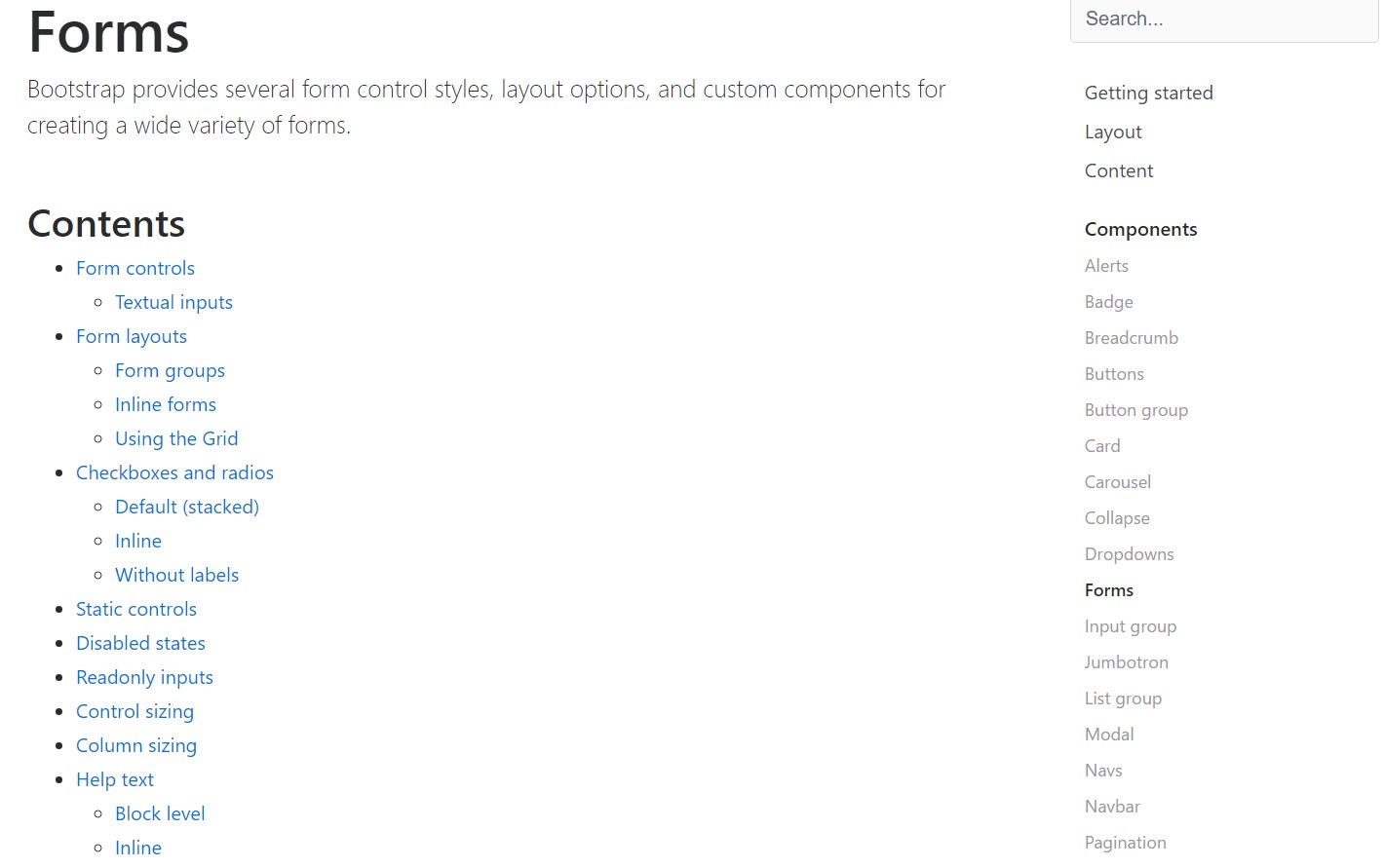
Bootstrap information
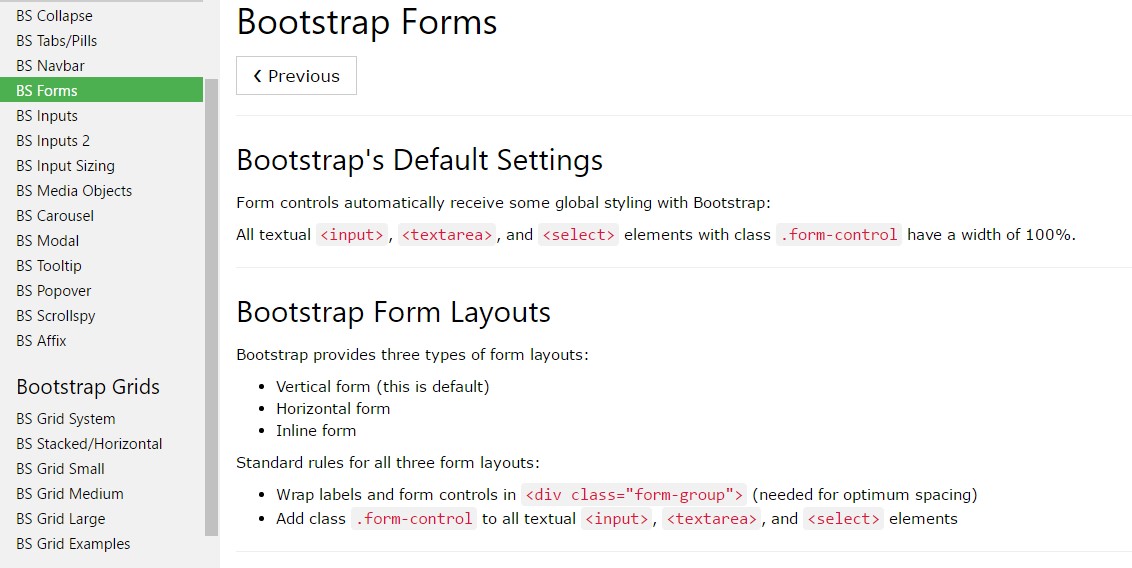
Support for Bootstrap Forms
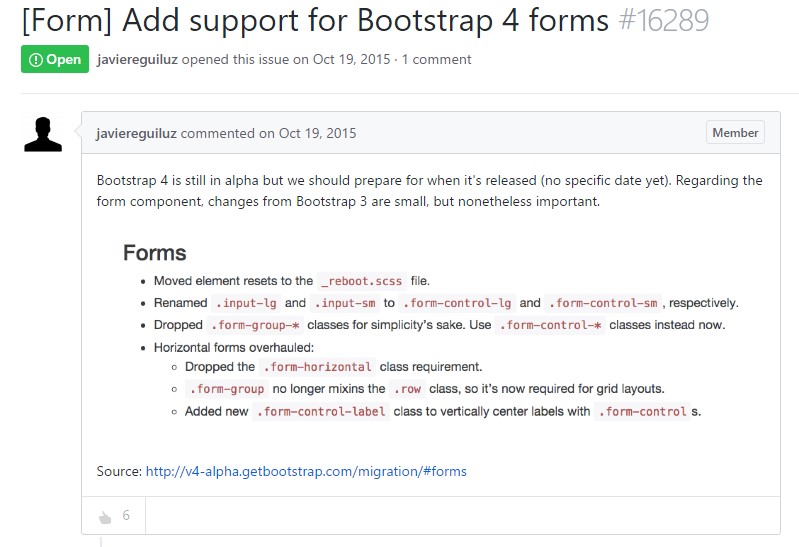
Let us inspect AMP project and AMP-form element?
